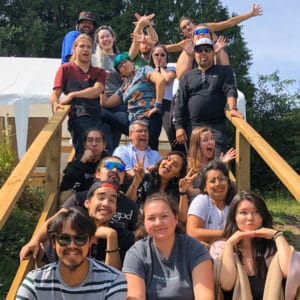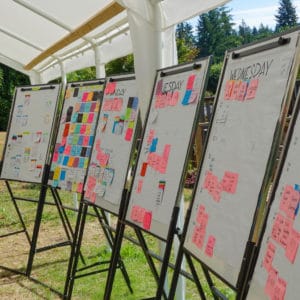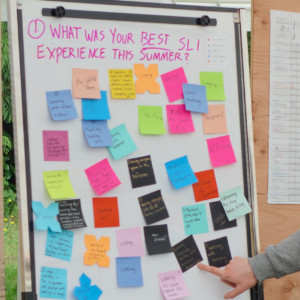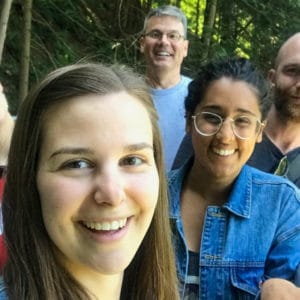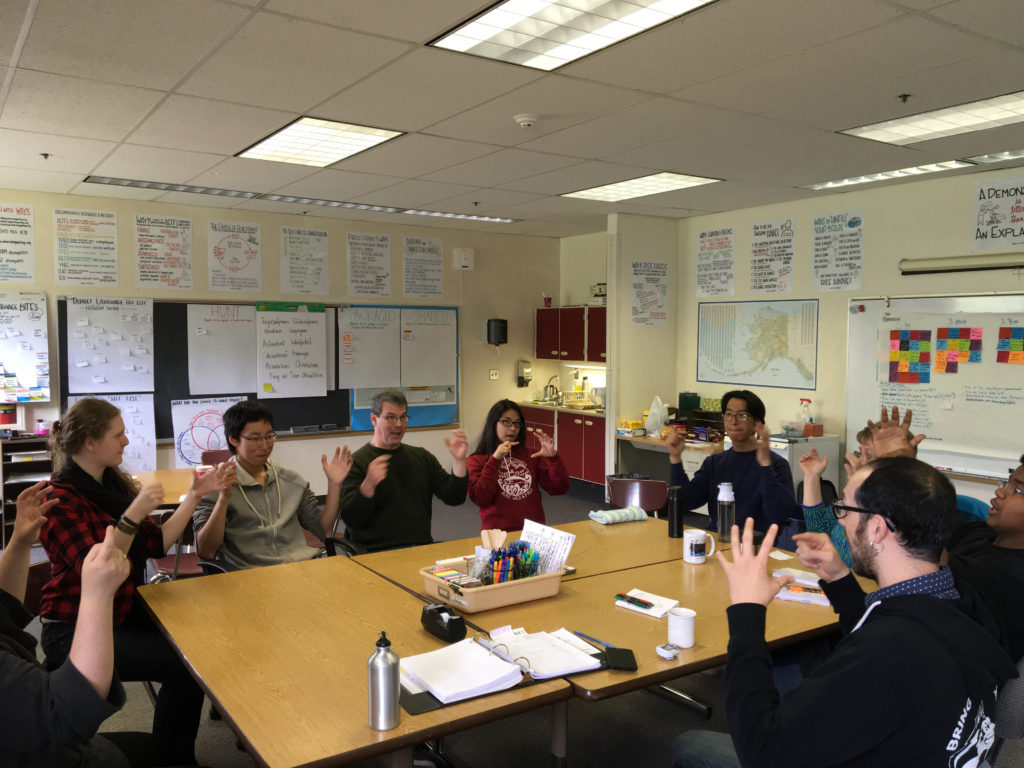
By way of the prior experience I’ve gained through my involvement in the language revitalization efforts taking place within my own community, the Pueblo of Pojoaque, I’ve been able to correct many misconceptions related to the practice of learning and teaching a second language. My time as an intern with WAYK has further contributed to these clarifications by making me more comfortable and confident in the fact that the process should be both a challenging, and, at times, uncomfortable one. The reason for this is that, if it’s not, there are probably essential opportunities for language learning and language barrier breakthroughs that are being missed. One example of such a scenario is the creation and maintenance of an ‘Immersion Bubble.’ That is, a particular space in which only the target language is spoken. However, this doesn’t mean that it shouldn’t or can’t be fun as well. In fact, the element of fun is one that must not be overlooked. This is where WAYK does a great job of finding the balance between these seemingly two extremes, resulting in more meaningful progress, more often.
An immersion bubble is formed once the target language is used within a particular space and keeps its form as long as English (or whatever the dominant language happens to be) is not spoken, no matter how much silence might take place in between what’s spoken in the target language (Silence as immersion! This is where ‘signed exact [insert target language here]’ is especially useful.). In today’s society of instant gratification, many are all too accustomed with “knowing now.” In the language learning environment, this often means asking the speaker to directly translate various terms and phrases so that we can feel some, albeit false, sense of accomplishment, further contributing to the practice of learning lots of isolated terms sans any real skill for being able to utilize them once in contact with fluent speakers (something I’m 100% guilty of). With the WAYK method, we only speak in full sentences and never use the dominant language to translate (that’s how fairies die). Sounds somewhat challenging, right? Well, it is. But! it’s also VERY fulfilling and provides for a much better understanding of the grammar structure of the target language, one that hoarding isolated words and phrases obtained through direct translation lacks.
But while being in an immersion bubble can be fun all on its own for some, for others, it can put them in an uncomfortable position, one in which insecurity and uncertainty can overpower their ability to see the larger picture of language revitalization and the purpose of the bubble. Fortunately, WAYK techniques (all of which help to keep the immersion bubble formed) can help with this. One such technique is called ‘Stopwatch.’ The way it works is that a stopwatch is started at the time an immersion bubble is formed (be sure to write down this time!) and only stops at those moments when the bubble is popped by the use of the dominant language (e.g., when fairies are killed through the use of direct translation). But once the language is spoken again, the bubble has been reformed and the time on the watch can run again. Using a stopwatch to track a group’s overall time in immersion helps them to maintain the bubble by making its members feel accountable to the watch and the time it is accumulating for the overall group (the more time on the clock, the better!). One thing to note is that it’s not about the complexity of the language you’re using, but about how long you’re using it for. In a group setting, everyone is sharing the same goal and so there is less pressure on any one member of the group to keep the bubble from popping.
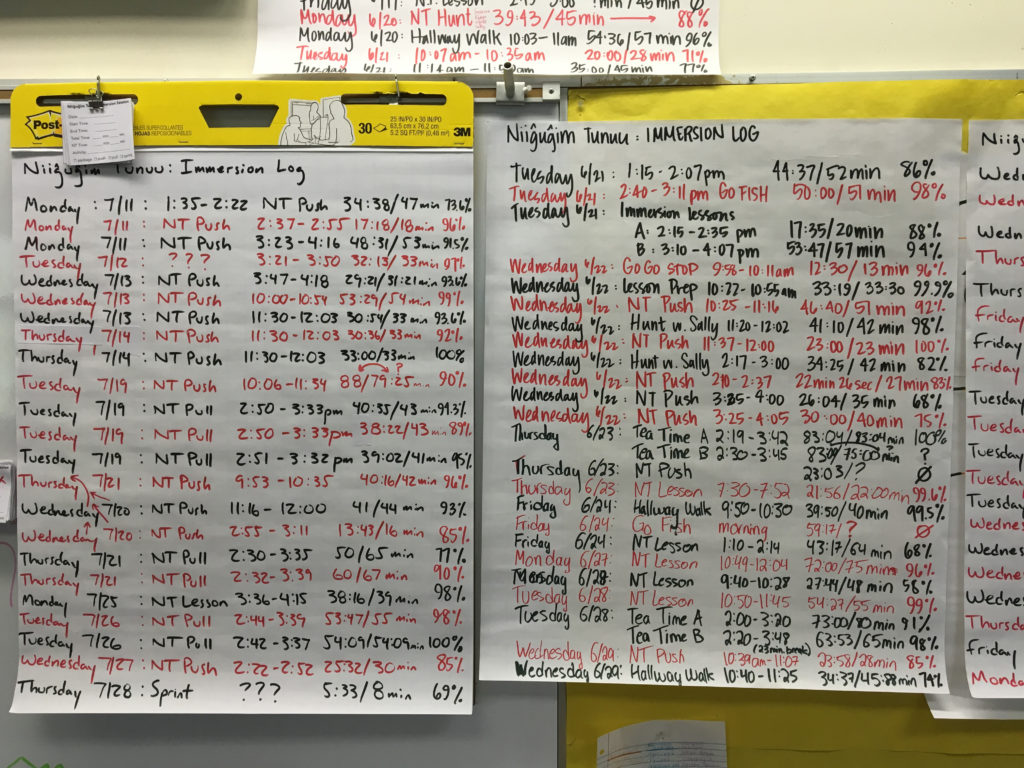
At the end of your language session in the bubble, the watch is stopped and the time in immersion is written down along with the overall time of the session (e.g., Total Time: 1 hour and 15 minutes/Immersion Time: 1 hour and 8 mins). From there, you can calculate the percentage of immersion time and record it (e.g., Percent in Immersion: 91%). These numbers then go alongside the data recorded for previous sessions of immersion in order to see the progress that’s being made as well as to remind everyone that you’re committed to creating and maintaining the immersion bubble once it’s been formed. WAYK pushes us to strive for a ‘Percent in Immersion’ of at least 90%.
But what to do when you’re not with your fellow group of learners? Maybe when you’re at home doing house work or on a long drive? How can an immersion bubble be created in that type of situation? One great method for establishing a bubble and becoming more comfortable and familiar with the sounds produced by the language and the ways in which it flows from a fluent speaker’s mouth (even when one might not know anything about the language) is to create what is called a listening CD/playlist – a compilation of songs, conversations, and stories that are all in the target language. This is something that can then be played and looped in the background while other things are going on in the space.*
Because many learners today don’t have the opportunity to hear their own heritage language being spoken on a daily basis, as was once the case in the not so distant past, over time, they may begin to feel that it is not useful and therefore not as important when comparing it to the ubiquitousness of their first language, the dominant one (more likely than not a direct result of past efforts to forcibly replace indigenous languages with the dominant and so-called “superior” language). While usually not overt in its appearance, as someone involved in language revitalization, I’ve come across this unfortunate situation many times. A listening CD/playlist can offer some, albeit artificial and minimal, relief to the absence of a heritage language being heard in spaces where it was once and should be in abundance. It is important to note that a listening CD/playlist isn’t necessarily meant to be learned from, in that, translation is not the goal. Instead, as one begins to be able to recognize various sounds and even words, when they enter the language learning environment, they will be a few steps ahead of the game.
Because it can be tempting to want to take the path of least resistance and switch to the dominant language in order to say what we’d like to say, learning to keep an immersion bubble formed takes practice and patience. But with fellow learners by your side, there is support, comfort, and fun (lots of it at times, actually) in numbers. For instance, after only two weeks of language learning, we at the WAYK house had our entire dinner in Niiĝuĝim Tunuu (the language of Atka, AK). There were definitely moments where I wanted to drop out of the conversation and just get the dang salt I had asked for fifteen minutes earlier, but in the end it was totally worth the time and effort in order to further hone my immersion-bubble-keeping-skills and to solidify my understanding of what was taking place. As proof of this, I recently led two half hour lessons in which we were able to keep the immersion bubble formed for at least 90% of the time in each (while using TQ: Stopwatch of course!). And in those instances when the bubbles were popped, we’d simply throw something like TQ: How Fascinating and “blow” a new bubble, getting right back into the groove of things.
*Note: Even once the dominant language is spoken in the space and the immersion bubble is popped, the listening CD/playlist is still beneficial as it provides heritage language where there once was once very little or even none.
Post authored by Samuel.

